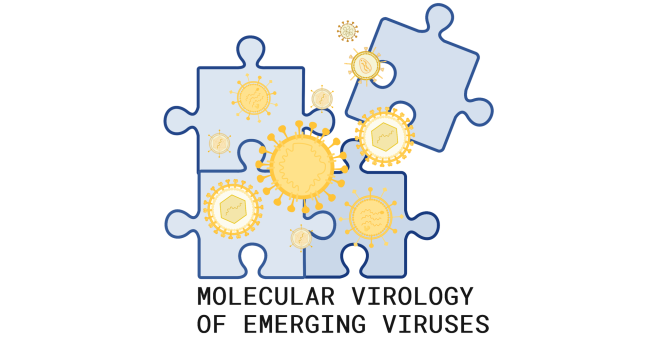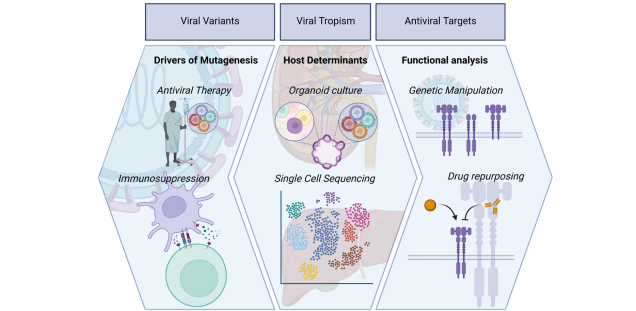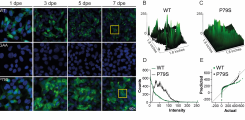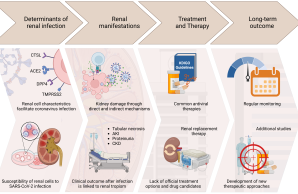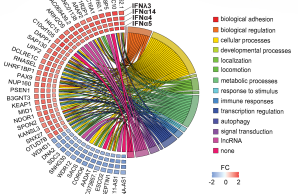Molecular Virology of Emerging Viruses
Emerging viral infections pose a continual threat to human health, encompassing a spectrum of diseases from mild to severe, and sometimes fatal, outcomes. These infections arise from newly identified or (re-)emerging viruses, often crossing species barriers to infect humans.
Such infections not only challenge public health systems but also strain social and economic resources globally. Recent outbreaks, exemplified by Zika virus, Ebola virus, and the severe acute respiratory syndrome coronavirus 2 pandemic, underscore the urgent need for robust preparedness and response strategies to mitigate their impact. As these viruses continue to evolve and adapt, understanding their mechanisms of transmission, pathogenesis, and immune evasion becomes paramount in safeguarding human health and preventing future pandemics.
Team
Toni L. Meister
In October 2023, Toni started her research group "Molecular Virology of Emerging Viruses" at the IIRVD. The junior research group is funded by the German Centre for Infection Research (DZIF) in the research area Emerging Infections.
Toni Meister received her Bachelor of Science in Plant Biotechnology with a focus on molecular biological methods from Leibniz Universität Hannover in 2015. In 2017, she completed her Master of Science in Biomedicine at the Hannover Medical School.In 2021, she completed her PhD at the Department of Molecular and Medical Virology at the Ruhr University Bochum. Her doctoral research focused on viral and host determinants in the hepatitis E virus replication cycle. She has also contributed to various research projects on SARS-CoV-2 and other respiratory viruses. After completing her PhD, Toni Luise Meister worked as a postdoctoral researcher in the same department and further developed her expertise in virology across a wide range of viruses. Her work has been recognised on several occasions with the Best-Season Paper Award from the Society for Virology. She has also served as an expert in the development of guidelines for handling aerosol-transmitted pathogens and is a member of the Society for Virology (GfV) and Infect-Net.
Lukas Daniel Sandoval Flores, B.Sc.
Technical assistant
Lukas is a biological technician and holds a bachelor of science in biology with over five years of professional experience in molecular biology, cell biology, and biochemistry research. He has contributed to multiple research projects focused on understanding the molecular mechanisms of skeletal disorders and DNA damage repair. In 2024 he joined the junior research group investigating determinants of viral tropism.
Topic: Hepatotropism of MPXV: Implications for Viral Pathogenesis and Disease Outcomes
Mpox virus (MPXV), an orthopoxvirus closely related to variola virus, exhibits a broad tissue tropism, which is critical to understanding its pathogenesis and clinical manifestations. Among its potential targets, the liver has emerged as an organ of interest. Evidence from clinical observations and animal models suggests that MPXV can indeed infect the liver. Hepatic involvement in MPXV infection has clinical implications, as liver dysfunction can exacerbate systemic symptoms and complicate disease management. Understanding MPXV's tropism for the liver is crucial for developing targeted therapies, monitoring biomarkers of severe disease, and improving clinical outcomes.
My Linh Ly
Master Student
My Linh is a medical laboratory technician with over 15 years of experience in laboratory science and clinical research. Ten years ago, she joined the lab of Prof. Addo as a lab manager. She has advanced expertise in techniques such as PCR, FACS, ELISpot and ELISA, as well as clinical trial coordination. She contributed to multiple research papers on infectious diseases including Ebola and MERS-CoV and holds certificates in GLP, GCP and genetic engineering project leadership. In 2024 she joined the junior research group for her master thesis in biomedical sciences.
Topic: Resistance of RSV to Nirsevimab and Palivizumab: Emergence of Escape Variants
Respiratory Syncytial Virus (RSV) remains a significant cause of severe respiratory illness, particularly in infants and immunocompromised individuals. Monoclonal antibodies, such as Nirsevimab and Palivizumab, have been developed to target RSV and reduce its morbidity and mortality. However, the efficacy of these interventions is challenged by the emergence of escape variants—viral strains with mutations that reduce the binding affinity of these antibodies, thereby diminishing their neutralizing capacity.
Escape variants arise due to selective pressure exerted by widespread use of monoclonal antibody therapies. These variants may carry mutations in the F protein, the primary target for both Nirsevimab and Palivizumab, altering key epitopes recognized by these antibodies. The identification and characterization of these escape variants are critical for understanding the limitations of current therapies and guiding the development of next-generation monoclonal antibodies or combination therapies.
Anna-Lena Rupp, M.Sc.
Anna-Lena Rupp will start her PhD Thesis in Toni's group in April 2025.
Projects
-
Viral Variants
Viral Variants
Approximately 22% of the global population display at least one underlying condition, which puts them at higher risk of adverse outcomes for infectious diseases. Indeed, the recent SARS-CoV-2 pandemic highlighted the vulnerability of specific populations with co-morbidities towards less favourable disease outcomes. Amongst those, immunosuppressed patients have become the focus of attention. This group includes individuals with various malignancies and immunologic diseases, as well as patients who have undergone solid organ transplantation. The latter are typically treated with immunosuppressive drugs.
There is a consistent body of evidence reporting prolonged or chronic infections with SARS-CoV-2 in immunocompromised individuals. Certain reports even proposed that SARS-CoV-2 Variants of Concern (VOCs) which became globally dominant, including the Alpha variant, are thought to originate from individuals with compromised immune systems. This phenomenon has been observed in chronic infections with several viruses, such as DENV and hepatitis E virus (HEV). Continuous replication of the virus potentially favours the accumulation of mutations in order to adjust to environmental and immunological pressure and therefore presumably facilitates the emergence of new variants with enhanced epidemic potential. Additionally, immunocompromised patients often require pharmacological interventions to clear infections, which may also further drive viral mutagenesis. Direct acting antivirals such as the nucleotide analogue Remdesivir or Ribavirin (RBV) facilitate a so-called “error catastrophe” during viral replication, which leads to defective or replication-incompetent viral genomes and subsequent viral extinction. However, in some cases the selective pressure drives viral mutagenesis leading to the formation of intra-host populations.
The emergence of novel viral variants presents a risk to the general population by affecting various aspects such as transmission dynamics, public health measures, vaccine efficacy, antiviral treatment, disease severity, and pathogenesis, among others. Therefore, it is crucial to thoroughly investigate potential drivers of mutagenesis and understand the impact of specific mutations.
Here, we aimed to explore viral replication under immunosuppressive or antiviral therapy to better predict and manage the spread of variants, potentially leading to the development of new antiviral drugs and therapeutic strategies.
Publications
Meister TL, Brüggemann Y, Nocke MK, Ulrich RG, Schuhenn J, Sutter K, Gömer A, Bader V, Winklhofer KF, Broering R, Verhoye L, Meuleman P, Vondran FWR, Camuzet C, Cocquerel L, Todt D, Steinmann E. A ribavirin-induced ORF2 single-nucleotide variant produces defective hepatitis E virus particles with immune decoy function. Proc Natl Acad Sci U S A. 2022 Aug 23;119(34):e2202653119. doi: 10.1073/pnas.2202653119. Epub 2022 Aug 15. Link
Wißing MH, Meister TL, Nocke MK, Gömer A, Masovic M, Knegendorf L, Brüggemann Y, Bader V, Siddharta A, Bock CT, Ploss A, Kenney SP, Winklhofer KF, Behrendt P, Wedemeyer H, Steinmann E, Todt D. Genetic determinants of host- and virus-derived insertions for hepatitis E virus replication. Nat Commun. 2024 Jun 6;15(1):4855. doi: 10.1038/s41467-024-49219-8. Link
-
Viral Tropism
Viral Tropism
Viral tropism, the tendency of viruses to infect specific cell types or tissues within a host organism, is a fundamental aspect of viral pathogenesis. The ability of a virus to target and infect particular cells is determined by a complex interplay of viral and cellular factors. Some viruses exhibit a narrow tropism, infecting only a limited range of cell types, while others display a broader tropism, infecting multiple cell types throughout the body. Viral tropism can play a critical role in determining the outcome of infection. Understanding why certain viruses cause more severe disease in some individuals compared to others is crucial for developing effective treatments and preventive measures.
Therefore, we explore the intricate interactions between viral pathogens and their hosts, including host immune responses, viral genetic diversity, microenvironmental factors, and cellular susceptibility. By elucidating these factors, we aim to improve our understanding of viral pathogenesis and uncover the specific interactions between viral pathogens and host cells to identify novel drug targets and develop strategies to block viral entry or replication selectively.
PublicationsBärreiter VA, Meister TL. Renal implications of coronavirus disease 2019: insights into viral tropism and clinical outcomes. Curr Opin Microbiol. 2024 Jun;79:102475. doi: 10.1016/j.mib.2024.102475. Epub 2024 Apr 13. Link
-
Antiviral Targets
Antiviral Targets
Viral infections pose a significant global threat, contributing to disease, mortality, and economic losses. This raises significant concerns, especially given the limited availability of antiviral drugs for treating viral disease. Recent viral outbreaks including Zika (ZIKV), Ebola (EBOV), and the more recent SARS-CoV-2 pandemic highlight the urgent need for novel antiviral strategies. Therefore, identifying and targeting specific molecular components of viral entry, replication, and assembly processes offer promising avenues for intervention. Targeting viral entry mechanisms, such as viral surface glycoproteins and host cell receptors, can block the initial stages of infection and limit viral spread within the host. Additionally, one key antiviral target is viral replication machinery, including enzymes essential for viral genome replication and protein synthesis. Inhibiting these enzymes can disrupt viral replication cycles, preventing the production of infectious viral progeny. Host factors essential for viral replication and propagation also serve as potential antiviral targets. By disrupting host-virus interactions or modulating host immune responses, we can inhibit viral replication and reduce disease severity.
We aim to find agents that may exploit conserved viral structures or host factors shared among different viral families, providing a versatile approach to combating diverse viral infections.
Publications
Schuhenn J, Meister TL, Todt D, Bracht T, Schork K, Billaud JN, Elsner C, Heinen N, Karakoese Z, Haid S, Kumar S, Brunotte L, Eisenacher M, Di Y, Lew J, Falzarano D, Chen J, Yuan Z, Pietschmann T, Wiegmann B, Uebner H, Taube C, Le-Trilling VTK, Trilling M, Krawczyk A, Ludwig S, Sitek B, Steinmann E, Dittmer U, Lavender KJ, Sutter K, Pfaender S. Differential interferon-α subtype induced immune signatures are associated with suppression of SARS-CoV-2 infection. Proc Natl Acad Sci U S A. 2022 Feb 22;119(8):e2111600119. doi: 10.1073/pnas.2111600119. Link
Schrader JA, Burkard TL, Brüggemann Y, Gömer A, Meister TL, Fu RM, Mehnert AK, Dao Thi VL, Behrendt P, Durantel D, Broering R, Vondran FWR, Todt D, Kinast V, Steinmann E. EGF receptor modulates HEV entry in human hepatocytes. Hepatology. 2023 Jun 1;77(6):2104-2117. doi: 10.1097/HEP.0000000000000308. Epub 2023 Feb 7. PMID: 36745934; Link
-
Disinfection
Disinfection
Emerging viruses pose significant threats to global health due to their potential to cause widespread disease outbreaks and pandemics. Recent examples include the coronavirus disease 2019 (COVID-19) pandemic caused by severe acute respiratory syndrome coronavirus 2 (SARS-CoV-2) or Zika virus linked to congenital abnormalities. These pathogens often originate from zoonotic reservoirs, evolving rapidly to exploit new hosts and environments. A major obstacle in addressing emerging viruses is the frequent lack of vaccines and specific antiviral treatments during the early stages of an outbreak. In these instances, hygiene measures become the first and most critical line of defence to curb transmission. Among the most effective hygiene interventions are disinfectants. By investigating the factors influencing the efficacy of various disinfectants against different viral pathogens, this research aims to provide insights into optimizing disinfection protocols and contributes to more targeted and effective hygiene interventions. Hence, we conduct to evaluate the antiviral efficacy of oral rinses and their active ingredients, World Health Organisation (WHO)-recommended hand rub formulations I (ethanol based) and II (2-propanol based), as well as surface disinfectants and may more.
Different pathogens exhibit unique susceptibilities to disinfection methods, often requiring tailored solutions. Therefore, choosing appropriate disinfectants with proven efficacy against target viruses and following manufacturer instructions for proper application are essential for effective viral control and infection prevention.
Publications
Meister TL, Brüggemann Y, Todt D, Conzelmann C, Müller JA, Groß R, Münch J, Krawczyk A, Steinmann J, Steinmann J, Pfaender S, Steinmann E. Virucidal Efficacy of Different Oral Rinses Against Severe Acute Respiratory Syndrome Coronavirus 2. J Infect Dis. 2020 Sep 14;222(8):1289-1292. doi: 10.1093/infdis/jiaa471. Erratum in: J Infect Dis. 2021 Feb 13;223(3):541. doi: 10.1093/infdis/jiaa539. PMID: 32726430; PMCID: PMC7454736.
Meister TL, Friesland M, Frericks N, Wetzke M, Haid S, Steinmann J, Todt D, Pietschmann T, Steinmann E. Virucidal activity of oral, hand, and surface disinfectants against respiratory syncytial virus. J Hosp Infect. 2023 Nov;141:25-32. doi: 10.1016/j.jhin.2023.08.009. Epub 2023 Aug 23. PMID: 37625461.
Meister TL, Frericks N, Kleinert RDV, Rodríguez E, Steinmann J, Todt D, Brown RJP, Steinmann E. Inactivation of yellow fever virus by WHO-recommended hand rub formulations and surface disinfectants. PLoS Negl Trop Dis. 2024 Jun 20;18(6):e0012264. doi: 10.1371/journal.pntd.0012264. PMID: 38900788; PMCID: PMC11218936.
Meister TL, Tao R, Brüggemann Y, Todt D, Steinmann J, Timm J, Drexler I, Steinmann E. Efficient Inactivation of Monkeypox Virus by World Health Organization‒Recommended Hand Rub Formulations and Alcohols. Emerg Infect Dis. 2023 Jan;29(1):189-192. doi: 10.3201/eid2901.221429. Epub 2022 Nov 17. PMID: 36394568; PMCID: PMC9796202.
Publications
Publications Toni L. Meister
Virucidal activity of household laundry detergents and additives in simulated wash cycles
Konkol J, Becker B, Paulmann D, Steinmann E, Todt D, Meister T, Evers S, Dotzauer A, Weide M, Brill F
J APPL MICROBIOL. 2025 [Epub ahead of print].
Renal implications of coronavirus disease 2019: insights into viral tropism and clinical outcomes
Bärreiter V, Meister T
CURR OPIN MICROBIOL. 2024;79:.
MicroRNAs modulate SARS-CoV-2 infection of primary human hepatocytes by regulating the entry factors ACE2 and TMPRSS2
Khanal R, Heinen N, Bogomolova A, Meister T, Herrmann S, Westhoven S, Nocke M, Todt D, Jockenhövel F, Klein I, Hartmann L, Vondran F, Steinmann E, Zimmer G, Ott M, Brown R, Sharma A, Pfaender S
LIVER INT. 2024;44(11):2983-2995.
A comprehensive approach for evaluating the virucidal performance of domestic laundry detergents under practical conditions
Konkol J, Becker B, Paulmann D, Steinmann E, Todt D, Meister T, Evers S, Weide M, Dotzauer A, Brill F
J APPL MICROBIOL. 2024;135(3):.
Inactivation of yellow fever virus by WHO-recommended hand rub formulations and surface disinfectants
Meister T, Frericks N, Kleinert R, Rodríguez E, Steinmann J, Todt D, Brown R, Steinmann E
PLOS NEGLECT TROP D. 2024;18(6):.
Expression and localization of two β-carbonic anhydrases in Bienertia, a single-cell C4 plant
Nguyen T, Lee N, Frömling F, Meister T, Kim J, Offermann S, Hwang I
FRONT PLANT SCI. 2024;15:1506375.
Monitoring of hepatitis E virus in wastewater can identify clinically relevant variants
Rau F, Elsner C, Meister T, Gömer A, Kallies R, Dittmer U, Steinmann E, Todt D
LIVER INT. 2024;44(3):637-643.
Genetic determinants of host- and virus-derived insertions for hepatitis E virus replication
Wißing M, Meister T, Nocke M, Gömer A, Masovic M, Knegendorf L, Brüggemann Y, Bader V, Siddharta A, Bock C, Ploss A, Kenney S, Winklhofer K, Behrendt P, Wedemeyer H, Steinmann E, Todt D
NAT COMMUN. 2024;15(1):.
SARS-CoV-2 vaccination improves HBV seroconversion rate through heterological immunity
Anft M, Paniskaki K, Giglio T, Wellenkötter J, Blazquez-Navarro A, Meister T, Roch T, Giesecke-Thiel C, Westhoff T, Stervbo U, Pfaender S, Cinkilic O, Babel N
KIDNEY INT. 2023;103(1):223-225.
Impact of low eGFR on the immune response against COVID-19
Blazquez-Navarro A, Mittmann L, Thieme C, Anft M, Paniskaki K, Doevelaar A, Seibert F, Hoelzer B, Konik M, Berger M, Brenner T, Tempfer C, Watzl C, Meister T, Pfaender S, Steinmann E, Dolff S, Dittmer U, Witzke O, Stervbo U, Roch T, Or-Guil M, Westhoff T, Babel N
J NEPHROL. 2023;36(1):199-202.
Stability and Inactivation of Monkeypox Virus on Inanimate Surfaces
Meister T, Brüggemann Y, Todt D, Tao R, Müller L, Steinmann J, Steinmann J, Timm J, Drexler I, Steinmann E
J INFECT DIS. 2023;228(9):1227-1230.
Virucidal activity of oral, hand and surface disinfectants against respiratory syncytial virus
Meister T, Friesland M, Frericks N, Wetzke M, Haid S, Steinmann J, Todt D, Pietschmann T, Steinmann E
J HOSP INFECT. 2023;141:25-32.
Stability of pathogens on banknotes and coins: A narrative review
Meister T, Kirchhoff L, Brüggemann Y, Todt D, Steinmann J, Steinmann E
J MED VIROL. 2023;95(12):.
Efficient Inactivation of Monkeypox Virus by World Health Organization‒Recommended Hand Rub Formulations and Alcohols
Meister T, Tao R, Brüggemann Y, Todt D, Steinmann J, Timm J, Drexler I, Steinmann E
EMERG INFECT DIS. 2023;29(1):189-192.
Fading SARS-CoV-2 humoral VOC cross-reactivity and sustained cellular immunity in convalescent children and adolescents
Paniskaki K, Goretzki S, Anft M, Konik M, Lechtenberg K, Vogl M, Meister T, Pfaender S, Zettler M, Jäger J, Dolff S, Westhoff T, Rohn H, Felderhoff-Mueser U, Stervbo U, Witzke O, Dohna-Schwake C, Babel N
BMC INFECT DIS. 2023;23(1):818.
Increased SARS-CoV-2 reactive low avidity T cells producing inflammatory cytokines in pediatric post-acute COVID-19 sequelae (PASC)
Paniskaki K, Goretzki S, Anft M, Konik M, Meister T, Pfaender S, Lechtenberg K, Vogl M, Dogan B, Dolff S, Westhoff T, Rohn H, Felderhoff-Mueser U, Stervbo U, Witzke O, Dohna-Schwake C, Babel N
PEDIAT ALLERG IMM-UK. 2023;34(12):e14060.
Low avidity circulating SARS-CoV-2 reactive CD8+ T cells with proinflammatory TEMRA phenotype are associated with post-acute sequelae of COVID-19
Paniskaki K, Konik M, Anft M, Heidecke H, Meister T, Pfaender S, Krawczyk A, Zettler M, Jäger J, Gaeckler A, Dolff S, Westhoff T, Rohn H, Stervbo U, Scheibenbogen C, Witzke O, Babel N
FRONT MICROBIOL. 2023;14:1196721.
Prevalence of equine parvovirus-hepatitis in healthy broodmares in Ontario, Canada
Papapetrou M, Arroyo L, Meister T, Baird J, Steinmann E, Lillie B
CAN J VET RES. 2023;87(3):169-175.
EGF receptor modulates HEV entry in human hepatocytes
Schrader J, Burkard T, Brüggemann Y, Gömer A, Meister T, Fu R, Mehnert A, Thi V, Behrendt P, Durantel D, Broering R, Vondran F, Todt D, Kinast V, Steinmann E
HEPATOLOGY. 2023;77(6):2104-2117.
Humoral and cellular immune responses to repeated SARS‐CoV‐2 infection and vaccination in an individual living with HIV
Simsek A, Bessen C, Meister T, Urlaub D, Skaletz‐Rorowski A, Brockmeyer N, Overheu O, Reinacher‐Schick A, Faissner S, Watzl C, Pfaender S, Schmitz I, Potthoff A, Plaza-Sirvent C
J EUR ACAD DERMATOL. 2023;37(7):e825-e827.
Inferior cellular and humoral immunity against Omicron and Delta variants of concern compared with SARS-CoV-2 wild type in hemodialysis patients immunized with 4 SARS-CoV-2 vaccine doses
Anft M, Blazquez-Navarro A, Frahnert M, Fricke L, Meister T, Roch T, Stervbo U, Pfaender S, Westhoff T, Babel N
KIDNEY INT. 2022;102(1):207-208.
Inferior humoral and sustained cellular immunity against wild-type and omicron variant of concern in hemodialysis patients immunized with 3 SARS-CoV-2 vaccine doses compared with 4 doses
Cinkilic O, Anft M, Blazquez-Navarro A, Meister T, Roch T, Stervbo U, Pfaender S, Westhoff T, Babel N
KIDNEY INT. 2022;101(6):1287-1289.
Infection of young foals with Equine Parvovirus-Hepatitis following a fatal non-biologic case of Theiler's disease
Meister T, Arroyo L, Shanahan R, Papapetrou M, Reinecke B, Brüggemann Y, Todt D, Stang A, Hazlett M, Baird J, Steinmann E
VET MICROBIOL. 2022;274:109557.
A ribavirin-induced ORF2 single-nucleotide variant produces defective hepatitis E virus particles with immune decoy function
Meister T, Brüggemann Y, Nocke M, Ulrich R, Schuhenn J, Sutter K, Gömer A, Bader V, Winklhofer K, Broering R, Verhoye L, Meuleman P, Vondran F, Camuzet C, Cocquerel L, Todt D, Steinmann E
P NATL ACAD SCI USA. 2022;119(34):e2202653119.
A touch transfer assay to determine surface transmission of highly pathogenic viruses
Meister T, Brüggemann Y, Tamele B, Howes J, Steinmann E, Todt D
STAR PROTOC. 2022;3(2):101188.
Low Risk of Severe Acute Respiratory Syndrome Coronavirus 2 Transmission by Fomites: A Clinical Observational Study in Highly Infectious Coronavirus Disease 2019 Patients
Meister T, Dreismeier M, Blanco E, Brüggemann Y, Heinen N, Kampf G, Todt D, Nguyen H, Steinmann J, Schmidt W, Steinmann E, Quast D, Pfaender S
J INFECT DIS. 2022;226(9):1608-1615.
Nanoscale copper and silver thin film systems display differences in antiviral and antibacterial properties
Meister T, Fortmann J, Breisch M, Sengstock C, Steinmann E, Köller M, Pfaender S, Ludwig A
SCI REP-UK. 2022;12(1):7193.
Mouthrinses against SARS-CoV-2 - High antiviral effectivity by membrane disruption in vitro translates to mild effects in a randomized placebo-controlled clinical trial
Meister T, Gottsauner J, Schmidt B, Heinen N, Todt D, Audebert F, Buder F, Lang H, Gessner A, Steinmann E, Vielsmeier V, Pfaender S, Cieplik F
VIRUS RES. 2022;316:198791.
Immune Response in Moderate to Critical Breakthrough COVID-19 Infection After mRNA Vaccination
Paniskaki K, Anft M, Meister T, Marheinecke C, Pfaender S, Skrzypczyk S, Seibert F, Thieme C, Konik M, Dolff S, Anastasiou O, Holzer B, Dittmer U, Queren C, Fricke L, Rohn H, Westhoff T, Witzke O, Stervbo U, Roch T, Babel N
FRONT IMMUNOL. 2022;13:816220.
Superior humoral immunity in vaccinated SARS-CoV-2 convalescence as compared to SARS-COV-2 infection or vaccination
Paniskaki K, Konik M, Anft M, Meister T, Marheinecke C, Pfaender S, Jäger J, Krawczyk A, Zettler M, Dolff S, Westhoff T, Rohn H, Stervbo U, Witzke O, Babel N
FRONT IMMUNOL. 2022;13:1031254.
A Vector-Based Vaccine Dose After 3 Doses of mRNA-Based COVID-19 Vaccination Does Not Substantially Improve Humoral SARS-CoV-2 Immunity in Renal Transplant Recipients
Roch T, Rohn B, Blazquez-Navarro A, Meister T, Blanco E, Paniskaki K, Wellenkötter J, Zgoura P, Giglio T, Pfaender S, Stervbo U, Viebahn R, Cinkilic O, Westhoff T, Babel N
KIDNEY INT REP. 2022;7(4):932-934.
SARS-CoV-2 neutralizing camelid heavy-chain-only antibodies as powerful tools for diagnostic and therapeutic applications
Schlör A, Hirschberg S, Amor G, Meister T, Arora P, Pöhlmann S, Hoffmann M, Pfaender S, Eddin O, Kamhieh-Milz J, Hanack K
FRONT IMMUNOL. 2022;13:930975.
Differential interferon-α subtype induced immune signatures are associated with suppression of SARS-CoV-2 infection
Schuhenn J, Meister T, Todt D, Bracht T, Schork K, Billaud J, Elsner C, Heinen N, Karakoese Z, Haid S, Kumar S, Brunotte L, Eisenacher M, Di Y, Lew J, Falzarano D, Chen J, Yuan Z, Pietschmann T, Wiegmann B, Uebner H, Taube C, Le-Trilling V, Trilling M, Krawczyk A, Ludwig S, Sitek B, Steinmann E, Dittmer U, Lavender K, Sutter K, Pfaender S
P NATL ACAD SCI USA. 2022;119(8):.
Detection of pre-existing SARS-CoV-2-reactive T cells in unexposed renal transplant patients
Anft M, Blazquez-Navarro A, Stervbo U, Skrzypczyk S, Witzke O, Wirth R, Choi M, Hugo C, Reinke P, Meister T, Steinmann E, Pfaender S, Schenker P, Viebahn R, Westhoff T, Babel N
J NEPHROL. 2021;34(4):1025-1037.
Superior cellular and humoral immunity toward SARS-CoV-2 reference and alpha and beta VOC strains in COVID-19 convalescent as compared to the prime boost BNT162b2-vaccinated dialysis patients
Blazquez-Navarro A, Safi L, Meister T, Thieme C, Kaliszczyk S, Paniskaki K, Stockhausen M, Hörstrup J, Cinkilic O, Flitsch-Kiefner L, Marheinecke C, Steinmann E, Seibert F, Stervbo U, Westhoff T, Pfaender S, Roch T, Babel N
KIDNEY INT. 2021;100(3):698-700.
Disinfection of SARS-CoV-2 contaminated surfaces of personal items with UVC-LED disinfection boxes
Bormann M, Alt M, Schipper L, Sand L, Otte M, Meister T, Dittmer U, Witzke O, Steinmann E, Krawczyk A
VIRUSES-BASEL. 2021.
Pasteurization Inactivates SARS-CoV-2-Spiked Breast Milk
Conzelmann C, Groß R, Meister T, Todt D, Krawczyk A, Dittmer U, Stenger S, Münch J, Steinmann E, Müller J, Pfaender S
PEDIATRICS. 2021;147(1):.
Antiviral Effect of Budesonide against SARS-CoV-2
Heinen N, Meister T, Klöhn M, Steinmann E, Todt D, Pfaender S
VIRUSES-BASEL. 2021;13(7):.
Comparable Environmental Stability and Disinfection Profiles of the Currently Circulating SARS-CoV-2 Variants of Concern B.1.1.7 and B.1.351
Meister T, Fortmann J, Todt D, Heinen N, Ludwig A, Brüggemann Y, Elsner C, Dittmer U, Steinmann J, Pfaender S, Steinmann E
J INFECT DIS. 2021;224(3):420-424.
Virucidal Activity of Nasal Sprays Against Severe Acute Respiratory Syndrome Coronavirus 2
Meister T, Todt D, Brüggemann Y, Steinmann J, Banava S, Brill F, Steinmann J, Pfaender S, Steinmann E
J HOSP INFECT. 2021;120:9-13.
The folate antagonist methotrexate diminishes replication of the coronavirus SARS-CoV-2 and enhances the antiviral efficacy of remdesivir in cell culture models
Stegmann K, Dickmanns A, Gerber S, Nikolova V, Klemke L, Manzini V, Schlösser D, Bierwirth C, Freund J, Sitte M, Lugert R, Salinas G, Meister T, Pfaender S, Görlich D, Wollnik B, Groß U, Dobbelstein M
VIRUS RES. 2021;302:198469.
Comparison of the in-vitro efficacy of different mouthwash solutions targeting SARS-CoV-2 based on the European Standard EN 14476
Steinhauer K, Meister T, Todt D, Krawczyk A, Paßvogel L, Becker B, Paulmann D, Bischoff B, Pfaender S, Brill F, Steinmann E
J HOSP INFECT. 2021;111:180-183.
Improved cellular and humoral immunity upon a second BNT162b2 and mRNA-1273 boost in prime-boost vaccination no/low responders with end-stage renal disease
Stervbo U, Blazquez-Navarro A, Blanco E, Safi L, Meister T, Paniskaki K, Stockhausen M, Marheinecke C, Zimmer G, Wellenkötter J, Giglio T, Arora P, Pöhlmann S, Hoffmann M, Seibert F, Pfaender S, Roch T, Westhoff T, Cinkilic O, Babel N
KIDNEY INT. 2021;100(6):1335-1337.
Detection of SARS-CoV-2-specific memory B cells to delineate long-term COVID-19 immunity
Thieme C, Abou-El-Enein M, Fritsche E, Anft M, Paniskaki K, Skrzypczyk S, Doevelaar A, Elsallab M, Brindle N, Blazquez-Navarro A, Seibert F, Meister T, Pfaender S, Steinmann E, Witzke O, Westhoff T, Stervbo U, Heine G, Roch T, Babel N
ALLERGY. 2021;76(8):2595-2599.
The Magnitude and Functionality of SARS-CoV-2 Reactive Cellular and Humoral Immunity in Transplant Population Is Similar to the General Population Despite Immunosuppression
Thieme C, Anft M, Paniskaki K, Blazquez-Navarro A, Doevelaar A, Seibert F, Hoelzer B, Justine Konik M, Meister T, Pfaender S, Steinmann E, Moritz Berger M, Brenner T, Kölsch U, Dolff S, Roch T, Witzke O, Schenker P, Viebahn R, Stervbo U, Westhoff T, Babel N
TRANSPLANTATION. 2021;105(10):2156-2164.
Impaired Humoral but Substantial Cellular Immune Response to Variants of Concern B1.1.7 and B.1.351 in Hemodialysis Patients after Vaccination with BNT162b2
Thieme C, Blazquez-Navarro A, Safi L, Kaliszczyk S, Paniskaki K, Neumann I, Schmidt K, Stockhausen M, Hörstrup J, Cinkilic O, Flitsch-Kiefner L, Meister T, Marheinecke C, Pfaender S, Steinmann E, Seibert F, Stervbo U, Westhoff T, Roch T, Babel N
J AM SOC NEPHROL. 2021;32(11):2725-2727.
A realistic transfer method reveals low risk of SARS-CoV-2 transmission via contaminated euro coins and banknotes
Todt D, Meister T, Tamele B, Howes J, Paulmann D, Becker B, Brill F, Wind M, Schijven J, Heinen N, Kinast V, Mhlekude B, Goffinet C, Krawczyk A, Steinmann J, Pfaender S, Brüggemann Y, Steinmann E
ISCIENCE. 2021;24(8):102908.
A realistic touch-transfer method reveals low risk of transmission for SARS-CoV-2 by contaminated coins and bank notes
Todt D, Meister T, Tamele B, Howes J, Paulmann D, Becker B, Brill F, Wind M, Schijven J, Mhlekude B, Goffinet C, Krawczyk A, Steinmann J, Pfaender S, Brüggemann Y, Steinmann E
ISCIENCE. 2021.
A third vaccine dose substantially improves humoral and cellular SARS-CoV-2 immunity in renal transplant recipients with primary humoral nonresponse
Westhoff T, Seibert F, Anft M, Blazquez-Navarro A, Skrzypczyk S, Zgoura P, Meister T, Pfaender S, Stumpf J, Hugo C, Viebahn R, Roch T, Stervbo U, Babel N
KIDNEY INT. 2021;100(5):1135-1136.
COVID-19-Induced ARDS Is Associated with Decreased Frequency of Activated Memory/Effector T Cells Expressing CD11a+
Anft M, Paniskaki K, Blazquez-Navarro A, Doevelaar A, Seibert F, Hölzer B, Skrzypczyk S, Kohut E, Kurek J, Zapka J, Wehler P, Kaliszczyk S, Bajda S, Thieme C, Roch T, Konik M, Berger M, Brenner T, Kölsch U, Meister T, Pfaender S, Steinmann E, Tempfer C, Watzl C, Dolff S, Dittmer U, Abou-El-Enein M, Westhoff T, Witzke O, Stervbo U, Babel N
MOL THER. 2020;28(12):2691-2702.
Immune monitoring facilitates the clinical decision in multifocal COVID-19 of a pancreas-kidney transplant patient
Babel N, Anft M, Blazquez-Navarro A, Doevelaar A, Seibert F, Bauer F, Rohn B, Hoelzer B, Thieme C, Roch T, Meister T, Pfaender S, Steinmann E, Dittmer U, Schenker P, Amann K, Viebahn R, Stervbo U, Westhoff T
AM J TRANSPLANT. 2020;20(11):3210-3215.
Virucidal Efficacy of Different Oral Rinses Against Severe Acute Respiratory Syndrome Coronavirus 2
Meister T, Brüggemann Y, Todt D, Conzelmann C, Müller J, Groß R, Münch J, Krawczyk A, Steinmann J, Steinmann J, Pfaender S, Steinmann E
J INFECT DIS. 2020;222(8):1289-1292.
A Cell Culture Model for Producing High Titer Hepatitis E Virus Stocks
Meister T, Klöhn M, Steinmann E, Todt D
JOVE-J VIS EXP. 2020;(160):.
Virucidal efficacy of different formulations for hand and surface disinfection targeting SARS CoV-2
Steinhauer K, Meister T, Todt D, Krawczyk A, Paßvogel L, Becker B, Paulmann D, Bischoff B, Eggers M, Pfaender S, Brill F, Steinmann E
J HOSP INFECT. 2020.
Robust T Cell Response Toward Spike, Membrane, and Nucleocapsid SARS-CoV-2 Proteins Is Not Associated with Recovery in Critical COVID-19 Patients
Thieme C, Anft M, Paniskaki K, Blazquez-Navarro A, Doevelaar A, Seibert F, Hoelzer B, Konik M, Berger M, Brenner T, Tempfer C, Watzl C, Meister T, Pfaender S, Steinmann E, Dolff S, Dittmer U, Westhoff T, Witzke O, Stervbo U, Roch T, Babel N
CELL REP MED. 2020;1(6):100092.
Robust hepatitis E virus infection and transcriptional response in human hepatocytes
Todt D, Friesland M, Moeller N, Praditya D, Kinast V, Brüggemann Y, Knegendorf L, Burkard T, Steinmann J, Burm R, Verhoye L, Wahid A, Meister T, Engelmann M, Pfankuche V, Puff C, Vondran F, Baumgärtner W, Meuleman P, Behrendt P, Steinmann E
P NATL ACAD SCI USA. 2020;117(3):1731-1741.
Rapid Quantification of SARS-CoV-2-Neutralizing Antibodies Using Propagation-Defective Vesicular Stomatitis Virus Pseudotypes
Zettl F, Meister T, Vollmer T, Fischer B, Steinmann J, Krawczyk A, V’kovski P, Todt D, Steinmann E, Pfaender S, Zimmer G
VACCINES-BASEL. 2020.
Cell culture systems for the study of hepatitis E virus
Meister T, Bruening J, Todt D, Steinmann E
ANTIVIR RES. 2019.
Characterization of Equine Parvovirus in Thoroughbred Breeding Horses from Germany
Meister T, Tegtmeyer B, Brüggemann Y, Sieme H, Feige K, Todt D, Stang A, Cavalleri J, Steinmann E
VIRUSES-BASEL. 2019;11(10):.
Equine Parvovirus-Hepatitis Frequently Detectable in Commercial Equine Serum Pools
Meister T, Tegtmeyer B, Postel A, Cavalleri J, Todt D, Stang A, Steinmann E
VIRUSES-BASEL. 2019;11(5):.
Hepatitis E virus treatment and ribavirin therapy: viral mechanisms of nonresponse
Todt D, Meister T, Steinmann E
CURR OPIN VIROL. 2018;32:80-87.
Letzte Aktualisierung aus dem FIS: 15.04.2025 - 04:36 Uhr
